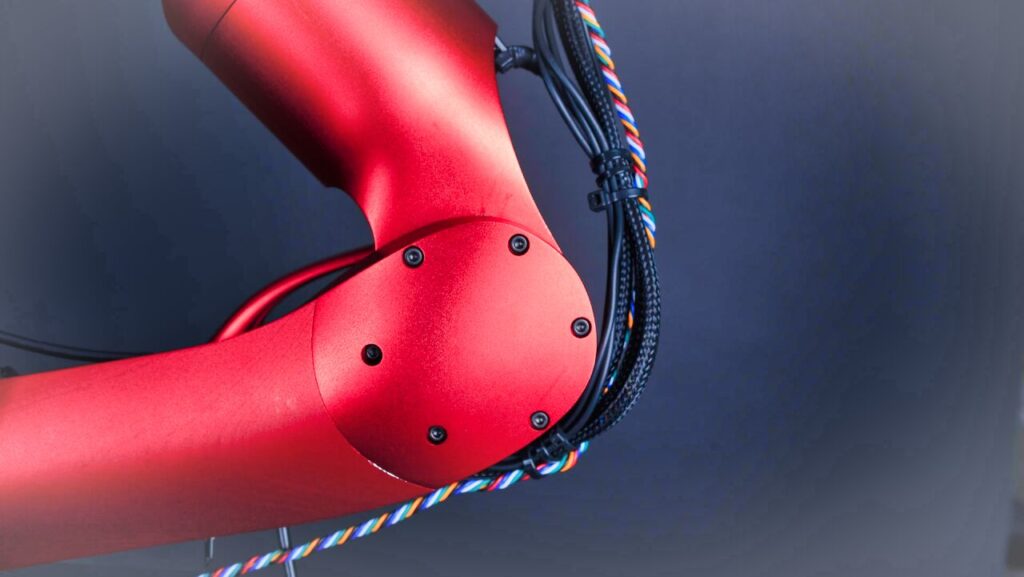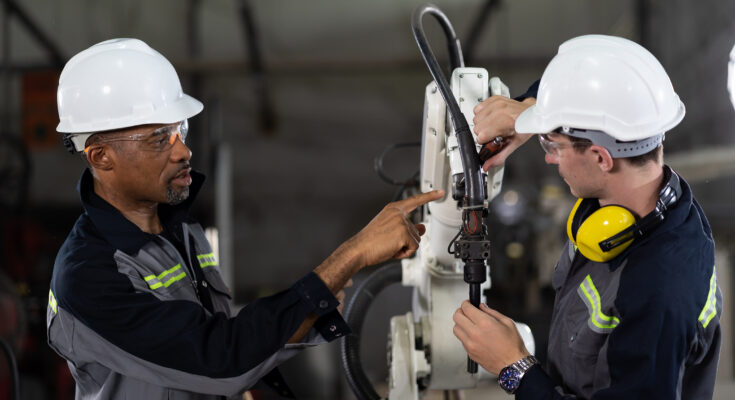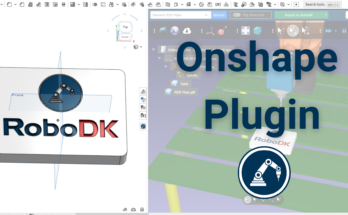Robot singularity avoidance is fundamental for controlling industrial robots. A singularity can become a serious issue for robot programmers and users, with real implications for productivity and quality.
When a robot’s control algorithms “break down” because of a kinematic singularity, it can cause the robot to behave in unpredictable or even dangerous ways. For example, if a painting robot changes its speed unexpectedly when it passes near a singularity, it will compromise the quality of the painting job.
Fortunately, there are various strategies for avoiding the negative effects of singularities in industrial robot programming.
Here are 9 strategies to keep your robot’s movements safe and predictable:
1. Add an Offset
The first singularity avoidance strategy is very simple. Robotics technicians have used it for decades. You simply add an offset to the robot’s tool in programming.
Singularities commonly occur when two of the robot’s axes line up in a particular way. For example, wrist singularities happen when Joint 4 and Joint 6 “become coincident”. By adding a small angle to the robot’s tool, you reduce the likelihood that the axes will align. However, this strategy can also introduce inaccuracies or complications because of the added offset.
2. Stop the Robot
A quick-and-dirty method for avoiding robot singularities is to program the robot to stop when it nears a singularity. This at least avoids any movements or behavior that could damage the robot.
You could apply this strategy in various ways. For instance, you could add a “stop point” or “danger zone” to the robot’s programming. When the robot entered this area, it would trigger a stop state.
Some problems with this solution include that it is inelegant and can be confusing for users who didn’t program the robot themselves because they don’t know why the robot has stopped.

3. Move the Task
A more elegant solution for singularity avoidance is to move the robot’s task to another area in its work envelope. This allows you to position the task so that it won’t run into any singularities.
This strategy requires that you understand a little about robot kinematics and reachability. One way to find the right space in the robot’s workspace is to do a reachability analysis. A tool like RoboDK can help enormously with this, with its inbuilt capability to visualize your robot’s workspace.
4. Use Cuspidal Robots
Cuspidal robots are those that are specifically designed to have no singularities. They can move freely within their work envelope and never reach a kinematic singularity.
The primary benefit of cuspidal robots is their ability to smoothly execute complex motions in a safe and stable manner. The potential problem is that this type of robot sometimes cannot execute simple moves. The programming techniques used to create a singularity-free motion can make the motions of the robot less precise, as avoiding singularities takes precedence over task accuracy.
5. Impose Joint Limits
A simple and effective solution to avoid some singularities is to impose joint limits in your robot programming. This prevents the joints in question from moving beyond certain angles, which would lead to the robot entering a singularity.
While this method is simple and effective, it restricts the robot’s motion. It effectively removes an entire section of the robot’s workspace. However, this might be acceptable for some tasks.

6. Learn to Recognize Singularities
One highly recommended strategy is to learn to recognize robot singularities when they occur. When you know what to look out for, you will be prepared for what to do when you see a singularity and you’ll have a better idea of how to solve the problem.
With experience, you will probably begin to develop an intuitive “feel” for your robot’s workspace and its singularities. This skill makes it much easier to avoid singularities when you create robot programs.
7. Become a Singularity Master
The next step up is to become a “singularity master.” This means learning more about the advanced mathematical concepts that cause singularities. With this understanding, you will have enough knowledge to create robot programs that elegantly detect and avoid singularities.
For most robot users, this level is probably overkill. The math behind singularities can be very complex. However, if your goal is to become a robotics expert, it’s a good idea to develop this skill set.
8. Add Dynamic Singularity Avoidance
Another strategy is to add dynamic singularity avoidance to the robot’s programming. This is where the robot adjusts its movements on-the-fly when it encounters a singularity. This is an effective strategy for tasks that require physical human-robot collaboration, as the robot will actively avoid touching the human operator.
One way to achieve this type of singularity avoidance is to add dynamic forces to the robot’s motions when it gets too close to a singularity. Researchers have successfully used this method in robot hand-guiding tasks and achieved good results.

9. Use Software with Automatic Singularity Detection
Finally, one of the most effective ways to avoid robot singularities is to use a robot programming software with automatic singularity detection. RoboDK has built-in singularity detection that is specifically designed to tell you if your chosen trajectory would pass through a singularity.
This makes programming much easier as you don’t need to worry whether the robot might enter a singularity when you are programming it.
Yes, singularities can be complex.
But, by following the strategies outlined above, you can ensure that your robot program is free from any problematic singularities. The better you can recognize kinematic singularities and adjust the operation of your robot to avoid them, the more stable and efficient your robot’s movements will be.
What strategies do you use to avoid robot singularities? Tell us in the comments below or join the discussion on LinkedIn, Twitter, Facebook, Instagram, or in the RoboDK Forum.. Also, check out our extensive video collection and subscribe to the RoboDK YouTube Channel




